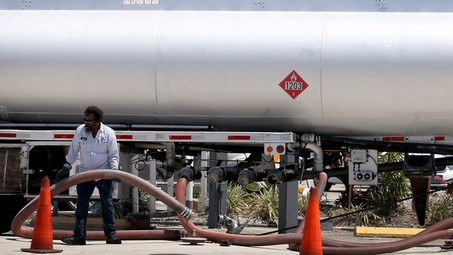Benchmark U.S. oil prices dropped below $60 a barrel for the first time since July 2009 as Saudi Arabia questioned the need to cut output, signaling its priority is defending market share.
West Texas Intermediate crude slid 1.6 percent in New York. The market will correct itself, according to Saudi Arabian Oil Minister Ali Al-Naimi. Global demand for crude from the Organization of Petroleum Exporting Countries will drop next year by about 300,000 barrels a day to 28.9 million, the least since 2003, the group predicted yesterday.
Oil’s collapse into a bear market has been exacerbated as Saudi Arabia, Iraq and Kuwait, OPEC’s three largest members, offered the deepest discounts on exports to Asia in at least six years. The group decided against reducing its output quota at a meeting last month, letting prices drop to a level that may slow U.S. production that’s surged to the highest level in more than three decades.
“The path of least resistance is lower,” Mike Wittner, head of oil research at Societe Generale SA in New York, said by phone. “This week we’ve had the Saudis cut prices to Asia, OPEC reduced the call on its crude and al-Naimi reiterated that they aren’t cutting output and letting the market do its work. They all reinforce the bearish message.”
WTI for January delivery dropped 99 cents to close at $59.95 a barrel on the New York Mercantile Exchange. It was the lowest settlement since July 14, 2009. Total volume was 14 percent above the 100-day average for the time of day. The U.S. benchmark is down 39 percent this year.
Maintain Quota
Brent for January settlement declined 56 cents to end the session at $63.68 a barrel on the London-based ICE Futures Europe exchange. It was the lowest close since July 16, 2009. Volume was 1.3 percent higher than the 100-day average. The North Sea crude closed at a $3.73 premium to WTI. Prices are down 43 percent in 2014.
“When you see a persistent trend like this you can be sure there are a lot of investors caught on the wrong side,” Bill O’Grady, chief market strategist at Confluence Investment Management in St. Louis, which oversees $2.4 billion, said by phone. “They are looking for any glimmer of green as an opportunity to get out of positions. Any moves higher will be of short duration.”
Collective Quota
Saudi Arabia led OPEC’s decision on Nov. 27 to maintain its collective quota at 30 million barrels a day, resisting calls from members including Venezuela to reduce output. The group pumped 30.56 million barrels a day in November, exceeding its target for a sixth straight month, a Bloomberg survey of companies, producers and analysts showed.
“Why should I cut production?” Al-Naimi said to reporters yesterday in Lima, Peru, where he’s attending United Nations climate talks. “This is a market and I’m selling in a market. Why should I cut?”
Venezuela wants special discussions to be held before the group’s next scheduled gathering on June 5, Foreign Minister Rafael Ramirez said on the Telesur network yesterday. The upfront cost of contracts to insure Venezuelan debt against non-payment for five years has jumped to 60 percent, pushing the implied probability of default to 94 percent, the highest in the world.
“Crude prices are back to 2005 levels and non-OPEC production will start to be challenged,” Olivier Jakob, managing director of Zug, Switzerland-based consultant Petromatrix GmbH, said by e-mail. “Venezuela might be a failed state before we start to see an impact on U.S. shale output.”
Biggest Discount
Kuwait offered the biggest discount to its Asian customers since December 2008, following Saudi Arabia and Iraq in reducing export prices. Kuwait Petroleum Corp. will sell its crude at $3.95 a barrel below a Middle East benchmark next month, the state-owned company said in a faxed statement yesterday.
“The market is in free fall,” Stephen Schork, president of Schork Group Inc., a consulting group in Villanova, Pennsylvania, said by phone. “Prices will continue to fall until the Saudis signal that they are prepared to take action or we see the global economy pick up.”
U.S. crude production expanded to 9.12 million barrels a day in the week ended Dec. 5, the Energy Information Administration reported yesterday. That’s the fastest rate in weekly records that started in January 1983, according to the EIA, the Energy Department’s statistical arm.
Fracking Boom
The nation’s oil boom has been driven by a combination of horizontal drilling and hydraulic fracturing, which has unlocked supplies from shale formations including the Eagle Ford in Texas and the Bakken in North Dakota.
“Is WTI at $60 enough to cause a meaningful cut in U.S. production this month? I don’t think so,” Christopher Bellew, senior broker at Jefferies International Ltd. in London, said by e-mail. “We will have to see lower prices before non-OPEC production cuts emerge.”
U.S. crude inventories increased by 1.45 million barrels to 380.8 million last week, the EIA said. Gasoline inventories jumped 8.2 million barrels to 216.8 million. That’s the biggest gain since September 2001.
Gasoline futures slipped 1.74 cents, or 1.1 percent, to close at $1.6244 a gallon on the Nymex. It was the lowest settlement since Sept. 25, 2009. Regular gasoline at the pump declined 1.8 cents to $2.621 a gallon yesterday, the least expensive since February 2010, according to Heathrow, Florida-based AAA, the nation’s biggest motoring group.


